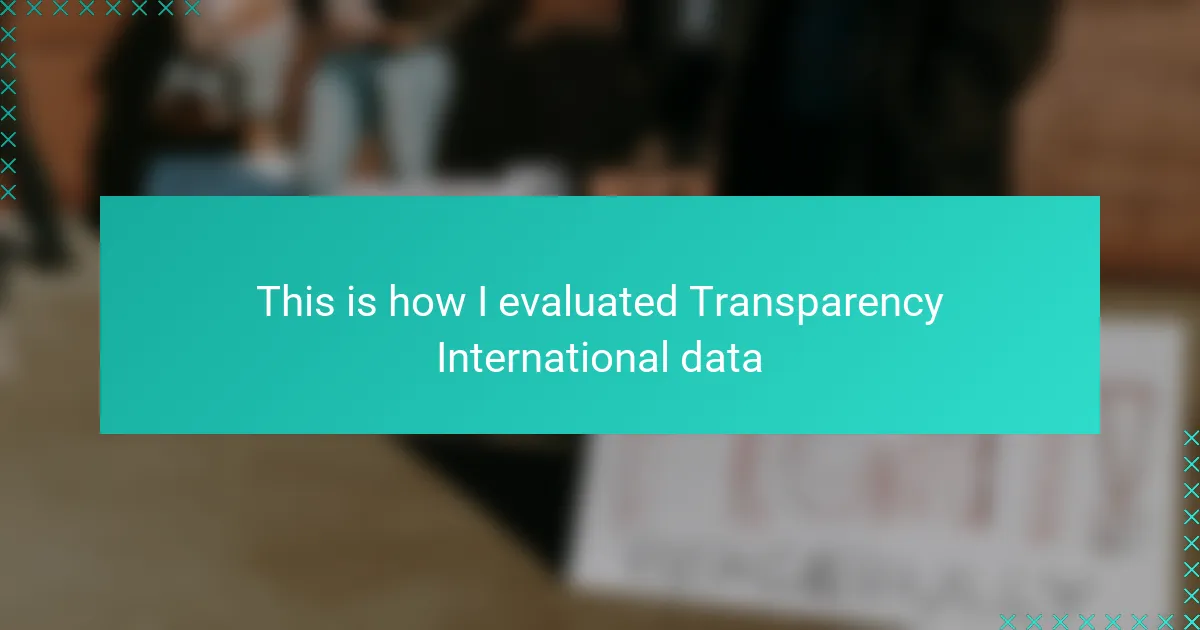Key takeaways
- Transparency International’s data combines expert assessments and citizen surveys, providing a balanced perspective on corruption perceptions.
- Key indicators in global politics serve as navigational tools, reflecting underlying political cultures and influencing policy decisions.
- Evaluating data quality involves cross-referencing with other sources, understanding potential biases, and ensuring transparency of methodology.
- Interpreting data requires embracing uncertainty, recognizing cultural biases, and being open to the complexities that scores may conceal.

Understanding Transparency International data
When I first encountered Transparency International’s data, I was struck by the sheer scale of their global reach—scores and rankings that attempt to capture perceptions of corruption across so many diverse countries. I found myself wondering, how reliable can perception-based data really be? Yet, after digging into their methodology, it became clear that they combine expert assessments with surveys from citizens, lending a balanced perspective between lived experience and professional judgment.
What truly resonated with me was how these numbers go beyond statistics; they reflect real frustrations and hopes from individuals and institutions facing corruption firsthand. I couldn’t help but feel a pang of empathy reading about countries struggling with transparency, especially knowing that these perceptions impact not just politics but everyday people’s trust in their governments. Have you ever thought about how much unseen corruption might still lie beneath these scores?
Evaluating this data means recognizing its nuances—Transparency International provides a snapshot, not the whole movie. It requires interpreting the scores with context, asking questions like: What cultural or political factors influence public perceptions here? That’s where understanding the data becomes more than reading numbers; it’s about connecting dots in a way that brings fresh insights into global political realities.
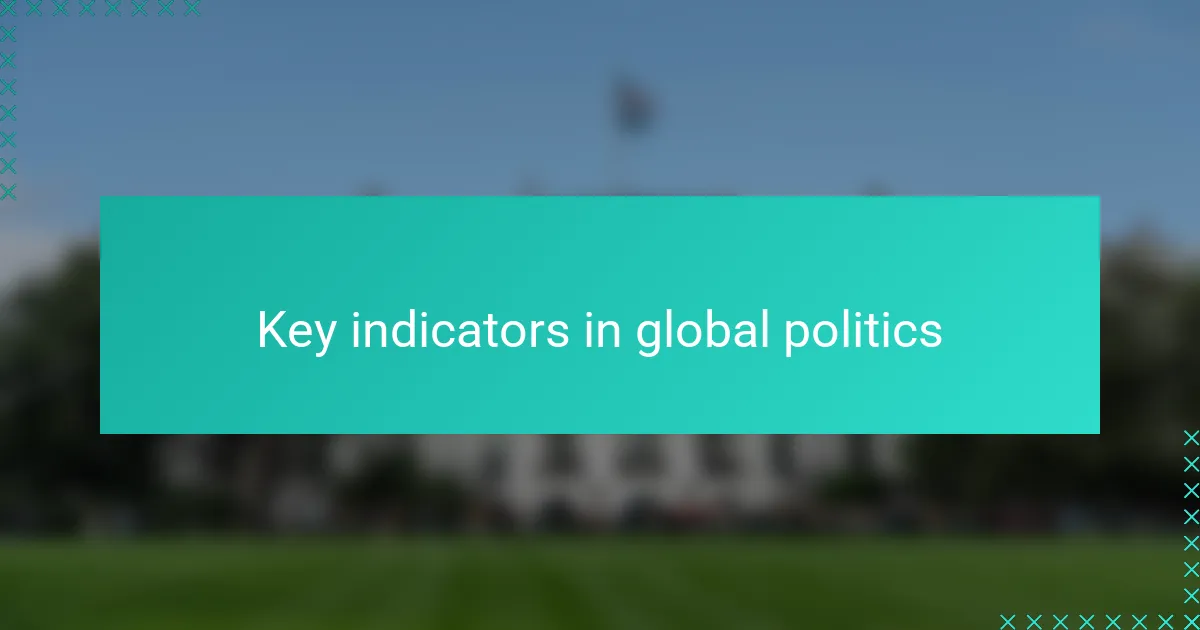
Key indicators in global politics
I’ve come to realize that key indicators in global politics, like the ones used by Transparency International, often tell stories beyond their numbers. Indicators such as corruption perception, rule of law, and government effectiveness paint a picture of how power is exercised and trusted. But I wonder, do these metrics fully capture the complexities on the ground, or are they just the tip of the iceberg?
One thing I’ve learned is that these indicators act like a compass—they guide us through the intricate maze of international relations, highlighting areas of vulnerability and strength. For example, when I see a low score in transparency, I start asking questions about the political culture driving that score and what it means for citizens’ daily lives. It’s more than just a statistic; it’s a window into the lived reality of governance.
At times, I find myself reflecting on how these indicators influence global policy decisions and aid allocations. They don’t exist in isolation—they spark debates, shape narratives, and sometimes even trigger reforms. Could it be that behind every number lies a call to action? From my experience, paying attention to these signals helps me make sense of shifting power dynamics and emerging political trends worldwide.

Methods for evaluating data quality
When I started evaluating Transparency International’s data quality, the first method I relied on was cross-referencing their scores with other reputable sources. It helped me check for consistency and spot any glaring anomalies. Have you ever noticed how a single outlier can suddenly change the narrative? That’s why this step felt crucial to me—data should tell a coherent story across different platforms.
Another approach I found invaluable was examining how Transparency International handles data collection biases. Since much of the data stems from perceptions, I paid close attention to the surveys’ design, sample size, and demographic diversity. It made me think: Are these voices truly representative, or do certain groups unintentionally get left out? This question kept me grounded, reminding me that even the best data is only as good as its sources.
Lastly, I looked into Transparency International’s transparency itself—how openly they share their methodology and revisions. It’s almost ironic, isn’t it? To trust data about transparency, the organization must shine a light on its own methods. When I saw the detailed explanations and regular updates, it boosted my confidence. Isn’t that openness what we should demand from all data providers in global politics?
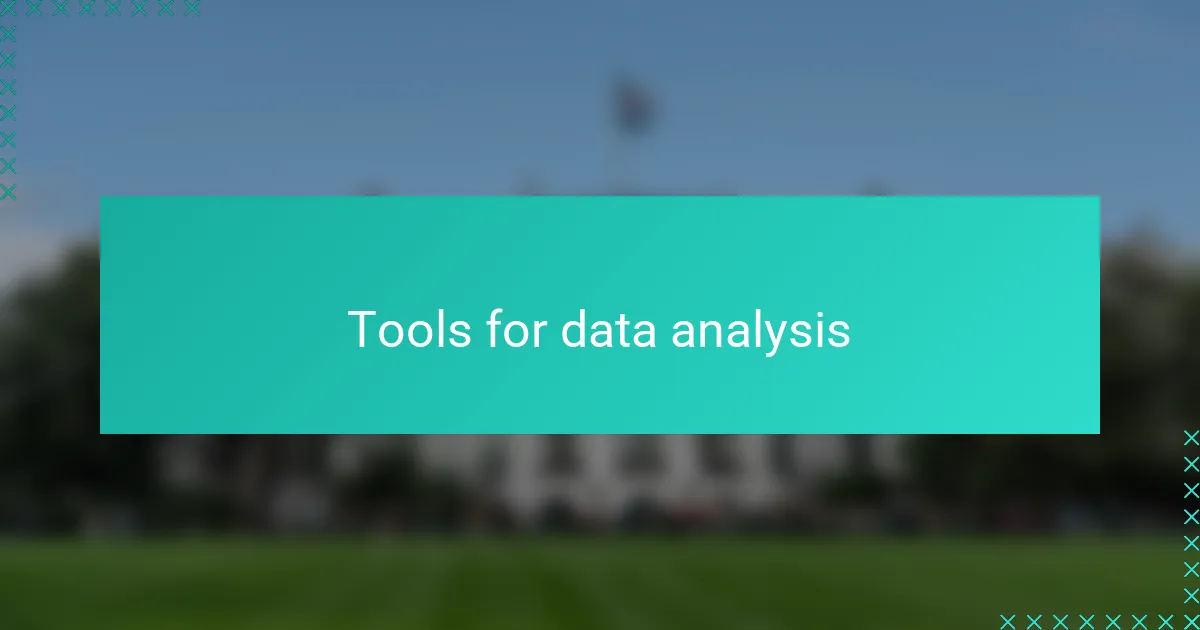
Tools for data analysis
When I dove into Transparency International’s data sets, I quickly realized that having the right tools made all the difference. Tools like Excel and statistical software such as R or Python’s pandas library helped me organize vast amounts of information, spot patterns, and run preliminary analyses with ease. Without these, I’d have felt overwhelmed, like trying to find a needle in a global haystack.
What really stood out to me was how visualization tools—think Tableau or even simple charts in Excel—transformed raw numbers into stories I could grasp visually. It’s one thing to see a corruption score; it’s another to watch how that score shifts over time or compares regionally. Don’t you find it easier to connect with data when you see it come alive through color and movement? For me, these visuals sparked insights that raw tables never could.
I also leaned heavily on qualitative data analysis tools to complement the numbers. Sometimes, the numerical scores hide nuances only uncovered through coded interviews or thematic analysis—tools like NVivo helped me stay organized when tackling Transparency International’s rich accompanying reports. Have you noticed that combining numbers with narratives often paints the clearest picture? It certainly did for me as I navigated the complex world of global transparency.
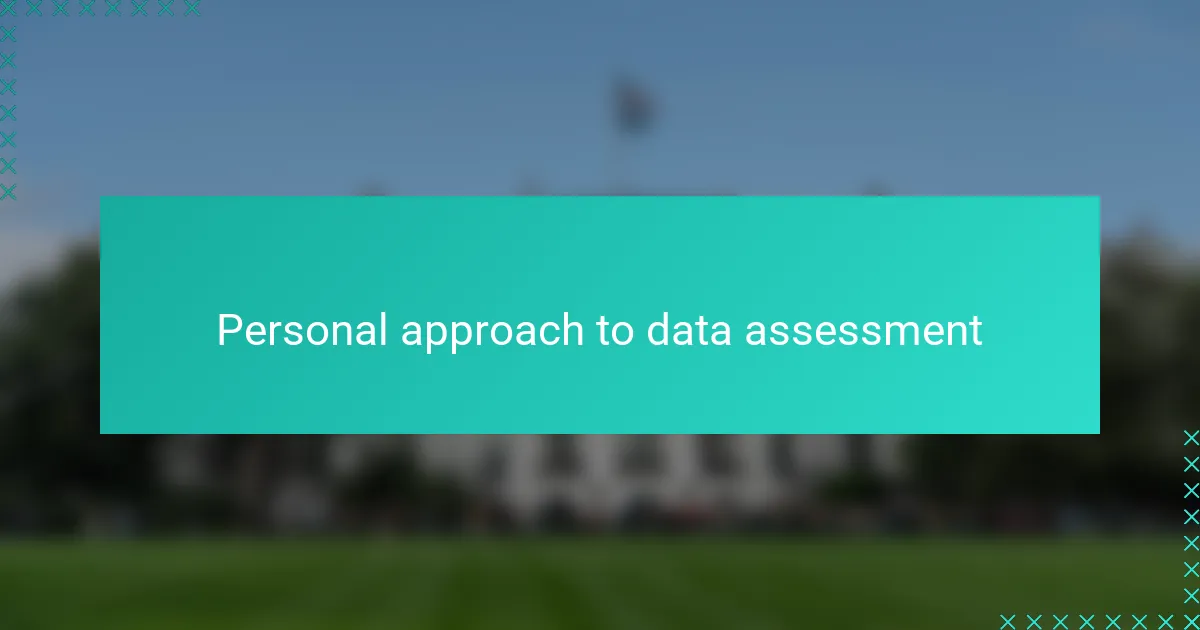
Personal approach to data assessment
When approaching Transparency International’s data, I always start by asking myself what story the numbers are trying to tell. It’s a bit like piecing together a puzzle where some pieces are clear and others blurred—I try not to take scores at face value but instead read between the lines. Have you ever felt that tension between trusting data and questioning its deeper meaning? That’s exactly where my assessment begins.
I also make it a practice to reflect on my own biases during evaluation. Because let’s be honest, no matter how objective we want to be, our background and experiences color how we interpret information. By acknowledging this upfront, I find it easier to remain critical and open-minded, treating the data as a conversation rather than an absolute truth. Does this self-awareness change how you view data too?
Finally, I balance quantitative analysis with intuition drawn from years of following global politics. Sometimes a surprising spike or drop in corruption perception might nudge me to look beyond the numbers—what recent events or policy changes could explain this shift? This blend of analysis and instinct makes data assessment feel more dynamic and connected to real-world complexities, rather than just cold statistics.
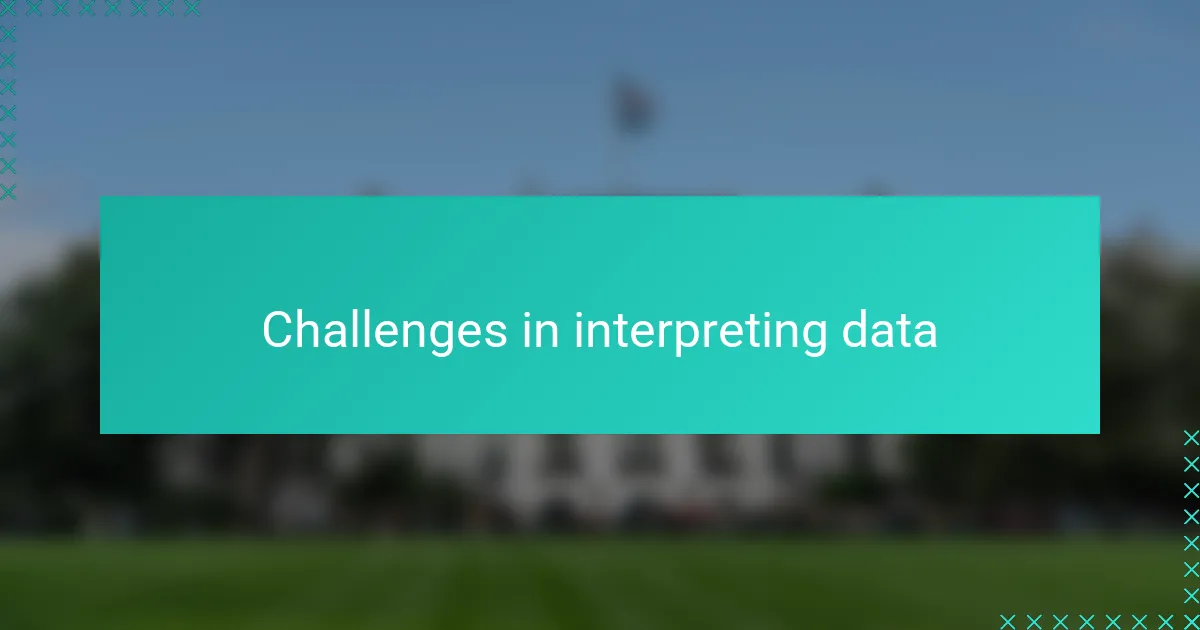
Challenges in interpreting data
Interpreting Transparency International’s data wasn’t as straightforward as I initially thought. For one, perception-based metrics can be heavily influenced by cultural norms or political climates, which means a low score in one country might reflect different underlying issues than a similar score elsewhere. Have you ever found yourself puzzled by how two countries with similar numbers face vastly different realities? That complexity kept me cautious about jumping to conclusions.
Another challenge I encountered is the risk of oversimplification. Corruption is a multi-layered problem, and boiling it down to a single score sometimes hides important nuances—like informal networks or localized practices—that the data can’t fully capture. I remember questioning whether those behind the numbers could truly grasp every subtlety without being on the ground. Doesn’t it make you wonder how much goes unseen behind these neat rankings?
Then there’s the issue of time lag and changes on the ground. A data point from last year might not reflect recent reforms or scandals, making the picture outdated by the time we’re analyzing it. I found myself constantly asking: Am I looking at a snapshot frozen in time, or a living story that’s already moved on? This uncertainty reminded me that data is a tool, not a crystal ball.
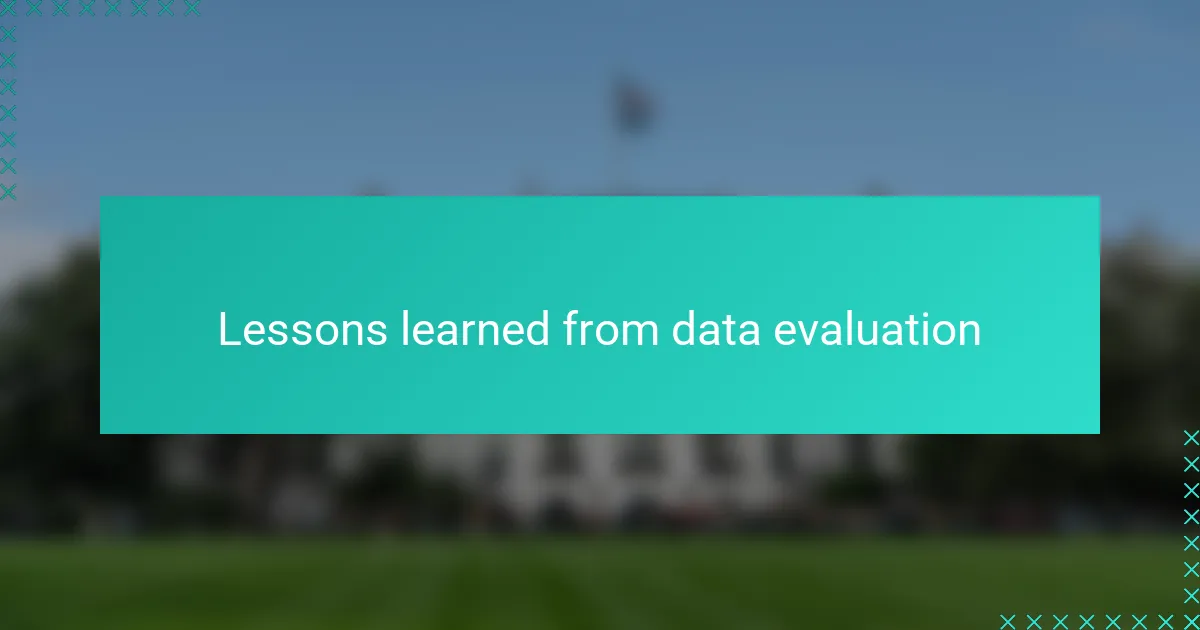
Lessons learned from data evaluation
One key lesson I took away from evaluating Transparency International’s data is the importance of embracing uncertainty. Early on, I felt frustrated when numbers didn’t neatly align across sources or when context seemed to slip through the cracks. But over time, I realized that wrestling with ambiguity is part of the process—it’s where deeper understanding lives. Have you ever found that grappling with unclear data actually pushed you to ask better questions rather than settle for simple answers?
Another insight that stuck with me is the value of critically examining the assumptions behind the data. For example, recognizing how cultural biases or survey limitations shape perceptions helped me resist the temptation to take scores at face value. It reminded me that numbers aren’t just cold facts; they’re lenses colored by human experience and institutional frameworks. Doesn’t that human element make data evaluation simultaneously challenging and fascinating?
Finally, I learned that patience and persistence pay off. At times, the data felt overwhelming or even contradictory, but sticking with it—revisiting sources, cross-checking, and reflecting on my own biases—led to richer, more nuanced conclusions. It made me appreciate that good analysis isn’t instant insight; it’s a dialogue between the data, the context, and my own informed curiosity. Have you noticed how slowing down sometimes reveals what’s invisible at first glance?
